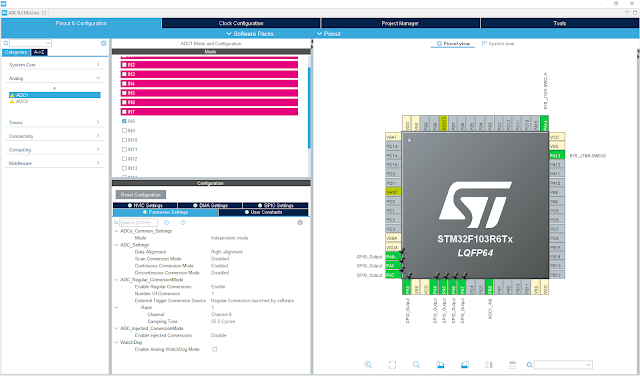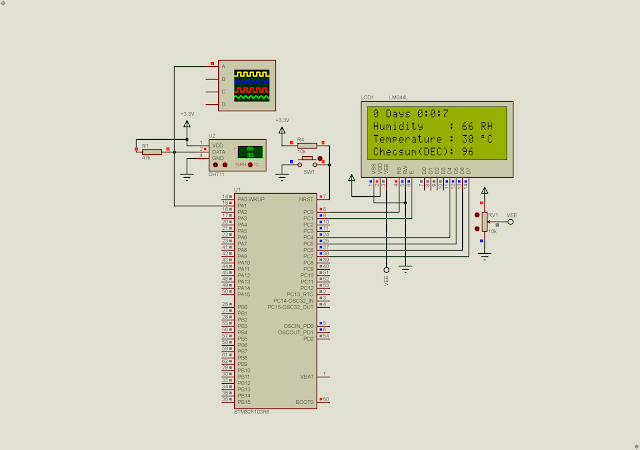Overview
The STM32F103R6 has two Analog to Digital Converter (ADC) module ADC1 and ADC2. The ADC is Successive Approximation Register type.They have the following features,
- 12-bit conversion result
- Up to 16 channels
- Result arrangement
- Conversion range is between 0 and 3.6V.
- Support interrupt and DMA feature.
There are a number of conversion modes,
- Single Conversion Mode
- Scan Single Conversion Mode
- Single Channel , Continuous Conversion Mode
- Scan Continuous Conversion Mode
- Injected Conversion Mode
- and Dual Mode.
For a single channel conversion mode, we should use the single channel continuous conversion mode to get a regular conversion result. To convert multiple ADC input channel we should use the scan continuous conversion mode.
ADC Interrupt and DMA is useful for fast response or real time signal application.
Most of STM32 micro-controllers have internal temperature sensor that can be read using its ADC module.
 |
| Simulating Program |
Using STM32CubeIDE
Hardware Abstraction Layer (HAL) and Code Configuration Tool allow us to easily configure the ADC module. We just need to select between ADC1 and ADC2 module.
We need to create a new STM32 project. In the Analog tab we click on ADC1. Then we will need to tick on any ADC channels.
 |
| Device Configuration Tool |
I select IN8 on the PA8 GPIO pin. I enable continuous conversion mode to get a periodic ADC conversion result. Regular conversion is also enabled. The start of conversion is triggered by software. IN8 is connected to Rank1 with the sample time of 55.5 cycles.
We will need these functions for ADC operation:
- HAL_StatusTypeDef HAL_ADC_Start(ADC_HandleTypeDef* hadc)
- HAL_ADC_PollForConversion(ADC_HandleTypeDef* hadc, uint32_t Timeout)
- HAL_ADC_GetValue(ADC_HandleTypeDef* hadc)
PA0 to PA7 are GPIO outputs connect to a character LCD. The LCD operates in 4-bit mode.
I use its internal RC clock of 8MHz frequency. Optionally we can select an appropriated debugger in the System Core tab.
In this example, the ADC will convert an analog input voltage fed by by a POT connects to PA8. It analog voltage varies between 0 to 3.3V. The conversion result will show on a character LCD.
If you have any doubt with LCD Interfacing with STM32 please see this post. Click here to download its source file.




No comments:
Post a Comment